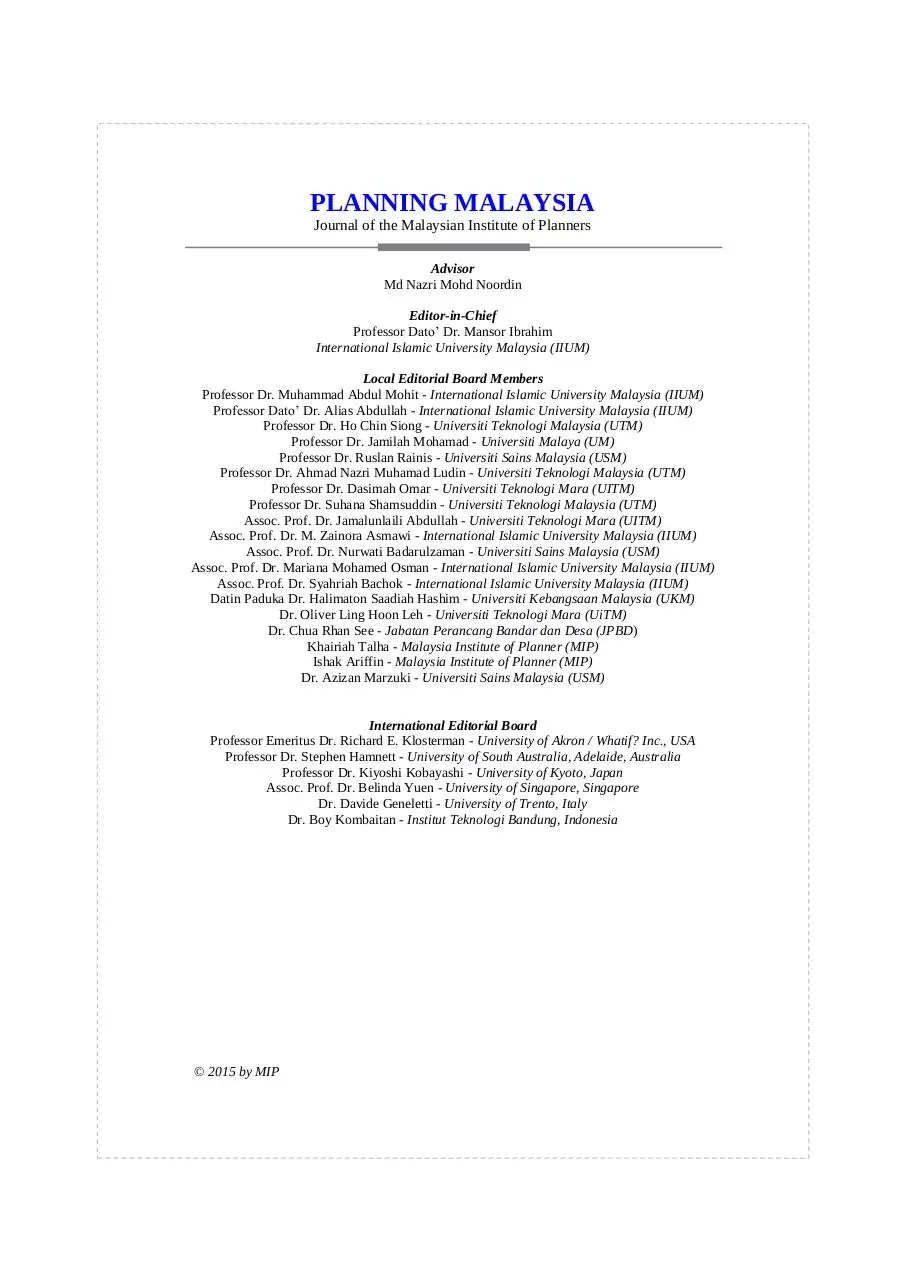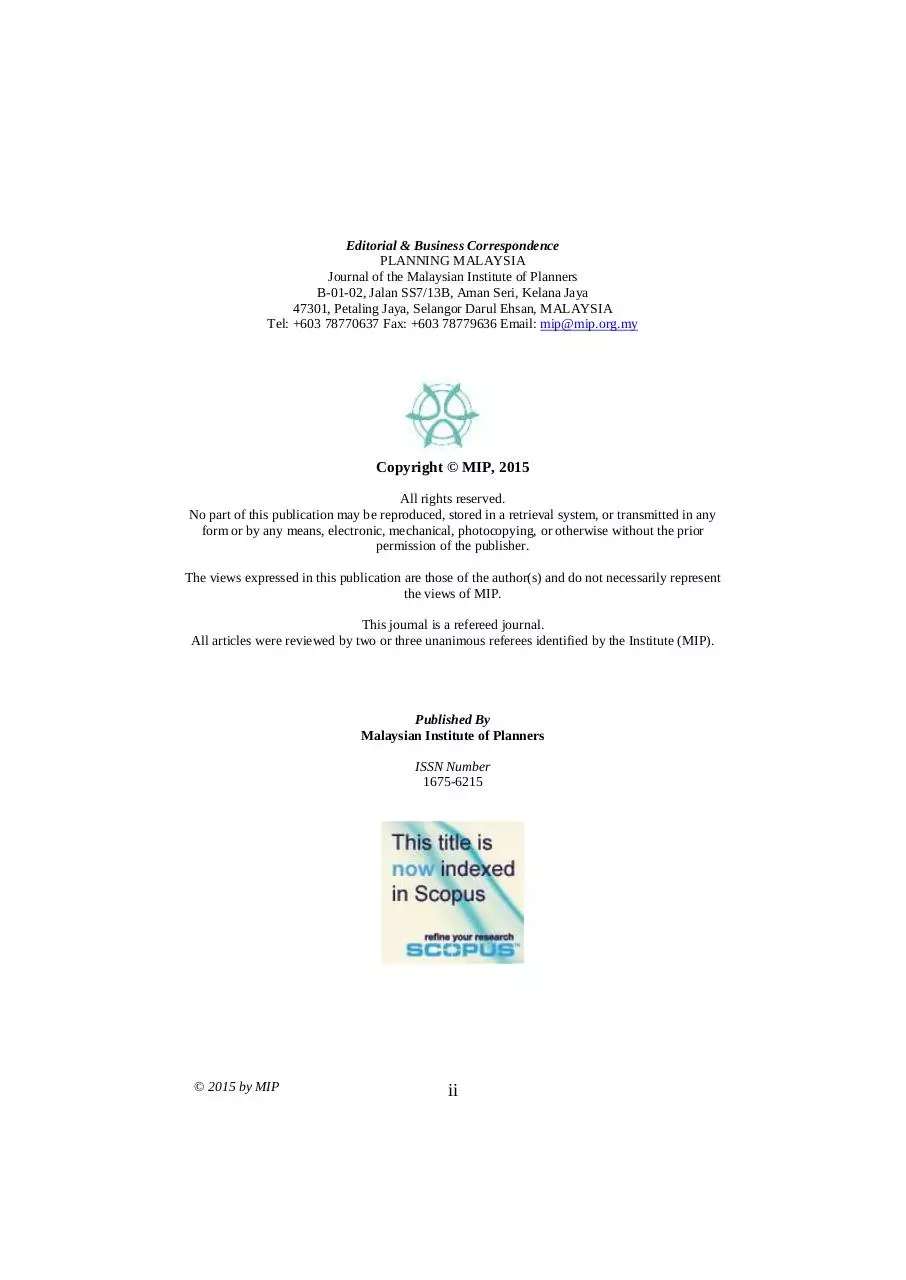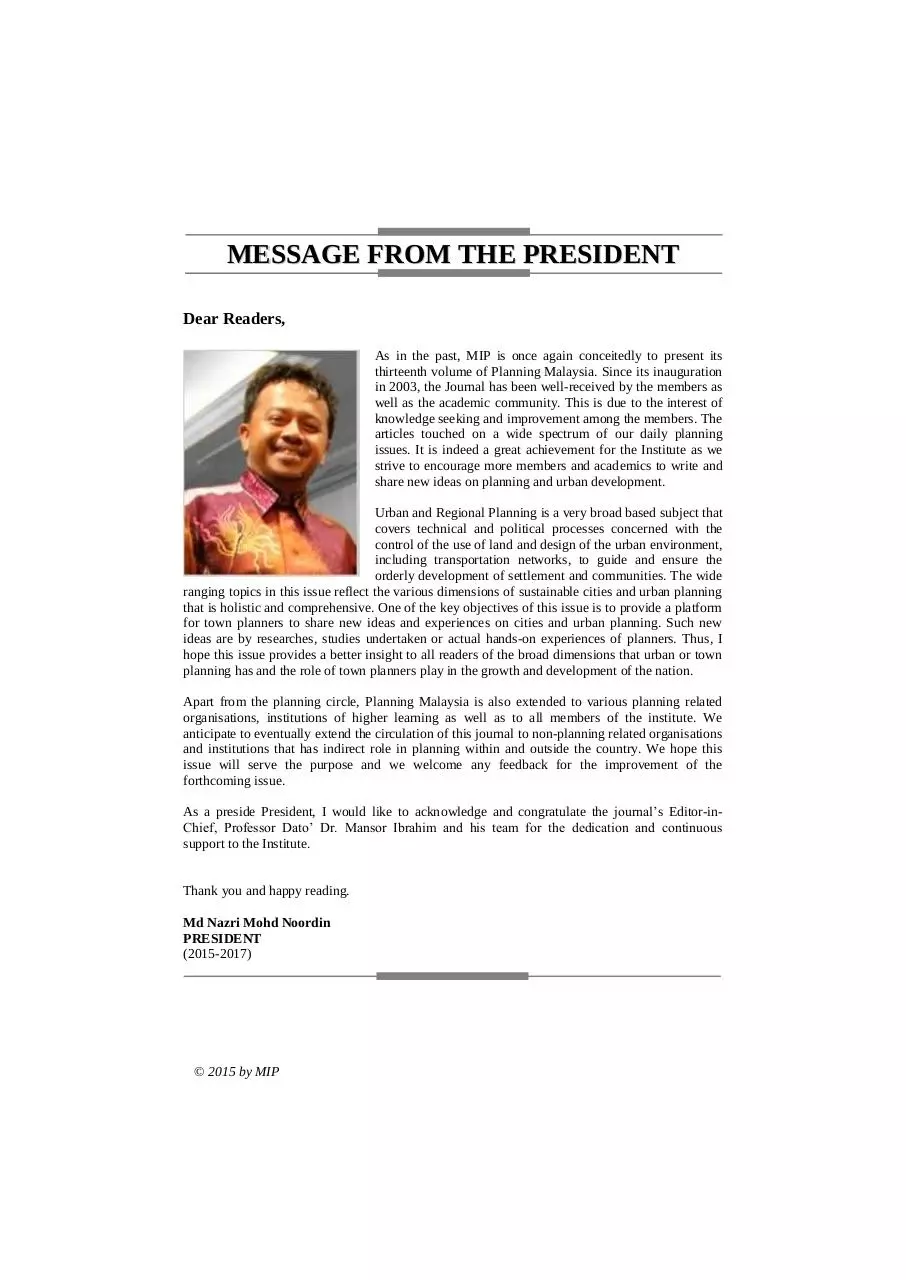APSA 2015 (PDF)
File information
Title: Wired & Wireless Media
Author: Prgen1
This PDF 1.5 document has been generated by Microsoft® Word 2013, and has been sent on pdf-archive.com on 02/07/2016 at 22:32, from IP address 175.143.x.x.
The current document download page has been viewed 3761 times.
File size: 1.78 MB (154 pages).
Privacy: public file





File preview
PLANNING MALAYSIA
Journal of the Malaysian Institute of Planners
Advisor
Md Nazri Mohd Noordin
Editor-in-Chief
Professor Dato’ Dr. Mansor Ibrahim
International Islamic University Malaysia (IIUM)
Local Editorial Board Members
Professor Dr. Muhammad Abdul Mohit - International Islamic University Malaysia (IIUM)
Professor Dato’ Dr. Alias Abdullah - International Islamic University Malaysia (IIUM)
Professor Dr. Ho Chin Siong - Universiti Teknologi Malaysia (UTM)
Professor Dr. Jamilah Mohamad - Universiti Malaya (UM)
Professor Dr. Ruslan Rainis - Universiti Sains Malaysia (USM)
Professor Dr. Ahmad Nazri Muhamad Ludin - Universiti Teknologi Malaysia (UTM)
Professor Dr. Dasimah Omar - Universiti Teknologi Mara (UITM)
Professor Dr. Suhana Shamsuddin - Universiti Teknologi Malaysia (UTM)
Assoc. Prof. Dr. Jamalunlaili Abdullah - Universiti Teknologi Mara (UITM)
Assoc. Prof. Dr. M. Zainora Asmawi - International Islamic University Malaysia (IIUM)
Assoc. Prof. Dr. Nurwati Badarulzaman - Universiti Sains Malaysia (USM)
Assoc. Prof. Dr. Mariana Mohamed Osman - International Islamic University Malaysia (IIUM)
Assoc. Prof. Dr. Syahriah Bachok - International Islamic University Malaysia (IIUM)
Datin Paduka Dr. Halimaton Saadiah Hashim - Universiti Kebangsaan Malaysia (UKM)
Dr. Oliver Ling Hoon Leh - Universiti Teknologi Mara (UiTM)
Dr. Chua Rhan See - Jabatan Perancang Bandar dan Desa (JPBD)
Khairiah Talha - Malaysia Institute of Planner (MIP)
Ishak Ariffin - Malaysia Institute of Planner (MIP)
Dr. Azizan Marzuki - Universiti Sains Malaysia (USM)
International Editorial Board
Professor Emeritus Dr. Richard E. Klosterman - University of Akron / Whatif? Inc., USA
Professor Dr. Stephen Hamnett - University of South Australia, Adelaide, Australia
Professor Dr. Kiyoshi Kobayashi - University of Kyoto, Japan
Assoc. Prof. Dr. Belinda Yuen - University of Singapore, Singapore
Dr. Davide Geneletti - University of Trento, Italy
Dr. Boy Kombaitan - Institut Teknologi Bandung, Indonesia
© 2015 by MIP
Editorial & Business Correspondence
PLANNING MALAYSIA
Journal of the Malaysian Institute of Planners
B-01-02, Jalan SS7/13B, Aman Seri, Kelana Jaya
47301, Petaling Jaya, Selangor Darul Ehsan, MALAYSIA
Tel: +603 78770637 Fax: +603 78779636 Email: mip@mip.org.my
Copyright © MIP, 2015
All rights reserved.
No part of this publication may be reproduced, stored in a retrieval system, or transmitted in any
form or by any means, electronic, mechanical, photocopying, or otherwise without the prior
permission of the publisher.
The views expressed in this publication are those of the author(s) and do not necessarily represent
the views of MIP.
This journal is a refereed journal.
All articles were reviewed by two or three unanimous referees identified by the Institute (MIP).
Published By
Malaysian Institute of Planners
ISSN Number
1675-6215
© 2015 by MIP
ii
CONTENTS
Message from The President
v
1. Creative Cities Research in Penang, Malaysia: A Review of Conceptual and
Methodological Framework
By: Khoo Suet Leng, Nurwati Badarulzaman, Narimah Samat, Morshidi Sirat
& Sharifah Rohayah Sheikh Dawood
1
2. The Role of Fabric Banners for Community Engagement in Digital Era
By: Rosilawati Zainol , Goh Hong Ching, Ibrahim Mohd, Nikmatul Adha
Nordin, Siti Maisara Baharom & Tengku Adeline Adura Tengku Hamzah
19
3. Thermal Comfort and Energy Solutions for a Better Residential
Environment in Malaysia
By: Noor Aziah Mohd Ariffin
37
4. The Relationship of Human Happiness and Neighbourhood Planning: Case
Study Puchong Indah Housing Estate, Selangor, Malaysia
By: Oliver Ling Hoon Leh, Farah Ayuni Marhalim, Siti Nur Afiqah Mohamed
Musthafa, Yusfida Ayu Abdullah & Marlyana Azyyati Marzukhi
51
5. Assessing the Urban and Rural Stage Bus Services Disparities in Peninsula
Malaysia
By: Zakiah Ponrahono, Syahriah Bachok, Mariana Mohamed Osman, Mansor
Ibrahim, Muhammad Faris Abdullah & Alias Abdullah
65
6. The Roles of Urban Heritage in Determining the Image of the Royal Town
of Sri Menanti, Negeri Sembilan
By: Nor Zalina Harun, Dg. Norhidayah Fairuz & Nor Adilla Nordin
85
7. Carbon Sequestration through Urban Green Reserve and Open Space
By: Alamah Misni, Sakurah Jamaluddin & Siti Mazwin Kamaruddin
101
8. Sustainable Governance in Relation to the Financial Aspect in Managing
Coastal Areas: Malaysian Experience
By: M.Zainora Asmawi, Lukman Hakim Mahamod, Mohd Zin Mohamed, &
Tuminah Paiman
123
Notes to contributors and guidelines for manuscript submission
139
The past issues (articles)
143
“Whoever travels in search of knowledge is on Jihād until he returns”
(Transmitted by Tirmidhi & Darimi)
© 2015 by MIP
MIP Council Members
(2015-2017 Session)
President
Md Nazri Mohd Noordin (301/94)
Vice President
Datin Hjh Noraida Saludin (468/02)
Assoc Prof Hj Ahmad Suhaimi Ismail (245/91)
Hon. Secretary
Datin Hjh Mazrina Dato' Abdul Khalid (559/09)
Hon. Treasury
Mohd Zamri Husin (430/01)
Council Members
Tn Hj Mohamad Nazri Jaafar (168/86)
Datin Noraida Saludin (468/02)
Mr Lee Lih Shyan (267/92)
Pn Mahani Mohd Yasin (614/12)
Prof Dato Dr Mansor Ibrahim (237/9
En Ishak Ariffin (239/90)
En Paridhonathrat Abd Razak
Pn Nurul Sheema Abd Rahman
En Nik Mohd Ruiz Nik Ahmad Fakhrul Razy
En Ismail Muhamad
Co-opted Members
Tn Hj Ihsan Zainal Mokhtar
Dr Ibrahim Mohd@Ahmad
Mr Chai Yek
Mr Cheah Lye Aik
En Abd Halim Ali Hassan
Advisory Council Members
Hj. Mohd. Ahyat Hj. Mohd. Nor
Dato' Mohd Fadzil b. Mohd Khir
En. Ho Khong Ming
Prof. Ezrin Arbi
Dato’ Mohd. Ishak Hj. Mohd. Ariff
Datin Paduka Dr. Halimatun Saadiah Hashim
En. Robert Gan Chin Huat
En. Ong Hong Fong
En. Lawrence Chan Kek Tong
Datuk Zainuddin Haji Muhammad
En. T. Mahesan
Dr. Mohd Thalha b. Haji Alithamby
Dato' Dr. Mohammad b. Nong
Pn Norliza Hashim
Pn. Khairiah Talha
Prof Dato' Dr Alias Abdullah
Tn. Hj. Mohamad Nazri Jaafar
Hon. Auditors
Saiful Azman Abdul Rashid (474/03)
A.Lokman Ab Ghani (597/12)
© 2015 by MIP
iv
MESSAGE FROM THE PRESIDENT
Dear Readers,
As in the past, MIP is once again conceitedly to present its
thirteenth volume of Planning Malaysia. Since its inauguration
in 2003, the Journal has been well-received by the members as
well as the academic community. This is due to the interest of
knowledge seeking and improvement among the members. The
articles touched on a wide spectrum of our daily planning
issues. It is indeed a great achievement for the Institute as we
strive to encourage more members and academics to write and
share new ideas on planning and urban development.
Urban and Regional Planning is a very broad based subject that
covers technical and political processes concerned with the
control of the use of land and design of the urban environment,
including transportation networks, to guide and ensure the
orderly development of settlement and communities. The wide
ranging topics in this issue reflect the various dimensions of sustainable cities and urban planning
that is holistic and comprehensive. One of the key objectives of this issue is to provide a platform
for town planners to share new ideas and experiences on cities and urban planning. Such new
ideas are by researches, studies undertaken or actual hands-on experiences of planners. Thus, I
hope this issue provides a better insight to all readers of the broad dimensions that urban or town
planning has and the role of town planners play in the growth and development of the nation.
Apart from the planning circle, Planning Malaysia is also extended to various planning related
organisations, institutions of higher learning as well as to all members of the institute. We
anticipate to eventually extend the circulation of this journal to non-planning related organisations
and institutions that has indirect role in planning within and outside the country. We hope this
issue will serve the purpose and we welcome any feedback for the improvement of the
forthcoming issue.
As a preside President, I would like to acknowledge and congratulate the journal’s Editor-inChief, Professor Dato’ Dr. Mansor Ibrahim and his team for the dedication and continuous
support to the Institute.
Thank you and happy reading.
Md Nazri Mohd Noordin
PRESIDENT
(2015-2017)
© 2015 by MIP
CREATIVE CITIES RESEARCH IN PENANG, MALAYSIA: A
REVIEW OF CONCEPTUAL AND METHODOLOGICAL
FRAMEWORK
Khoo Suet Leng1, Nurwati Badarulzaman2, Narimah Samat3, Morshidi Sirat4 &
Sharifah Rohayah Sheikh Dawood5
1
Department of Development Planning and Management
2
Department of Urban and Regional Planning
3,4&5
Department of Geography
UNIVERSITI SAINS MALAYSIA
Abstract
A heightened interest in the notions of ‘creative cities, creative industries and
creative economy’ has propelled research in these emerging areas of the New
Economy. As an emerging area, some conceptual and methodological issues
need to be addressed prior to adopting the creative city paradigm as part of the
strategic and policy framework towards a creative economy. This paper presents
a review of key conceptual and methodological issues that need to be
considered when conducting research on creative cities in Malaysia. The
conceptual and methodological issues relating to creative cities and creative
industries should be addressed and dealt with in order to facilitate an enabling
framework for contemporary research in this emerging area.
Keyword: Creative cities, creative industries, creative economy
© 2015 by MIP
vi
INTRODUCTION
The discourse on creative cities is gaining much importance and increasingly
pivotal in contemporary academic and political agenda. The discourse
deliberates on the intrinsic link between creativity and urban development, and
the contribution of creative activities towards territorial development and
competitiveness (Costa, 2008). Creative cities are purported as the model cities
of the 21st century, where cities of this nature would grow, thrive and progress
as a result of an agglomeration of creative industries, which feature a clustering
force of their skilled, innovative and creative urbane workforce (Florida, 2008,
2004, 2002; Lazzeretti, Boix & Capone, 2009; Cooke & Lazzeretti, 2008). The
presence of such creative workers or popularly known as the ‘creative class’
(Florida, 2002), will be the key determinant towards a city’s liveability,
attractiveness and future economic progress. Consequently, cities around the
world strive to compete to be the location of choice in their quest to attract and
retain the creative class.
Arguably, in the New Economy it is cities rather than countries or nations
that compete against each other for economic dominance and wealth. In
essence, a city needs to transform itself into a creative city in order to contest
effectively since “...the concept of creative city can be seen as the newest placemarketing product, employed in the struggle between cities to attract investors
and to promote competitiveness” (Hansel et al., 2001, cited in Costa, 2008).
Statistics from advanced economies such as the United Kingdom, Canada and
Singapore highlight the significance of creative industries clustering in cities
and their contributions towards local and national development (DCMS, 2010;
Cooke & Lazzeretti, 2008; AuthentiCity, 2008; Toh, Choo & Ho, 2003). Hence,
many developing countries including Malaysia share the same aspiration to
transform their primary or secondary cities to become creative cities (Lee, 2011;
Khoo & Nurwati, 2011). Specifically, Malaysia’s National Creative Industry
Policy aims to strengthen the local creative industries and leverage on the
creative economy bandwagon to spur economic progress.
However, critiques have underlined some key issues regarding the
conceptual and methodological comprehension of the notions of ‘creative
cities/creative industries/creative economies’ and their usability. The current
scenario depicts a “...rather confusing and unclear panorama around the corelated creative cities and creative/cultural activities concepts” (Costa, 2008:
188). Furthermore, “creative city notion has been particularly in the spotlight in
the past decade, but it is not easy to identify a common conceptual ground
covering the underlying diversity of interpretations and practices” (Costa, 2008:
191). Given the blurry boundaries between the notions of ‘creative activities’
© 2015 by MIP
and ‘cultural activities’, arguably, these conceptual issues are specific and
peculiar to creative industries and the notion of ‘creativity’ per se.
Apart from the conceptual predicaments, a lack of understanding of the
tangible dimensions and parameters of targeted economic performance poses
another challenge to current research on creative cities and creative industries.
The strength of a city’s creative economy is usually measured in terms of the
number of creative businesses, total number of creative employees, and total
wealth generated by the creative employees (CIE, 2009; Montgomery, 2005).
Admittedly, creative inputs that can boost tangible economic outcomes provide
vital statistics to operationalise and assess the “economic dimensions of creative
industries as a driver of wealth creation, employment, competitiveness and
prosperity” (CIE, 2009: 9). To date, however, most countries have yet to publish
the tangible economic dimensions and quantifiable objective indicators that are
related to their creative cities and creative industries (Costa, 2009). Data on
Malaysia’s creative industries based on selected economic indicators (or
proxies) is unavailable. This situation poses a real challenge given the dearth of
creative cities research in Malaysia.
Against this background, this paper aims to fill the above research gap by
reviewing the conceptual and methodological issues and challenges in creative
cities and creative industries research. Essentially, the main objective of this
paper is to disclose and unpack key conceptual issues and also latent
methodological challenges that are hindering and obstructing research and
practical developments in the field of creative cities and creative economies in
Malaysia. Though several diverse and contentious concepts were highlighted,
the convergent meaning found in the conceptual and methodological review
adds on to the rigour and internal consistency of the working framework for this
study. Issues and challenges discussed in this paper would provide some
baseline data for future research on creative cities, creative industries and
economic development especially in Malaysia. In addition, the Malaysian
authorities and related statutory bodies may devise an appropriate taxonomy to
document the contribution and development of creative industries as the city’s
latest engine of growth in the New Economy.
REVIEW OF CONCEPTUAL FRAMEWORK
Creative industries have multiple definitions and meanings; and the debate
continues on the inherent linkages that exist between creative industries and
cultural industries (Costa, 2008). The literature highlights two distinct
approaches in explaining the complex connections between creative industries
and cultural industries. The first approach hinges on the dimension of culture
and its supplementary contributions in the elements of politics, economics and
environment in order to provide a holistic and sustainable condition for the birth
of a creative city (Kern & Runge, n.d.; Landry, 2000). As the forces of
© 2015 by MIP
viii
economic globalisation set in, advanced economies rapidly lose their
manufacturing base and they progress into their next development phase with
the birth of a new knowledge and informational economy. Artistic and
technological creativity become the prime driver of the new knowledge
economy, thus, placing creativity as a focal point of urban development policy
(Sasaki, 2008). Interestingly, the link between culture and the arts is not novel;
and can be traced back to the pioneers of cultural economists like John Ruskin
and William Morris, who during England’s Victorian period championed the art
economics that capitalise on creative human activities (Sasaki, 2008). A similar
line of inquiry was later pursued by Lewis Mumford in Culture of Cities where
he proposed cultural economics, which emphasises human life and environment
over everything else, thus, placing much focus on “reconstitution of cities to
fulfil human consumption and creative activities” (Mumford, 1938, cited in
Sasaki, 2008: 78).
The second approach, on the other hand, hinges on economics and
development. The concept of creative cities has evolved to encapsulate the
dimensions of creativity and innovation of a city, as pioneered in Jane Jacobs’
work (1972). Extending from Jacobs’ work are proponents like Florida (2008,
2004, 2002) and Landry (2000) who define creativity as something beyond
fantasy and imagination. They place creativity somewhere between intelligence
and innovation, so that the concept acts as a “mediator” between art and culture
and between industry and technology (Sasaki, 2008). A creative economy
comprises creative industries fuelled by creative and innovative individuals (or
creative class) who choose to congregate and agglomerate with other creative
workers in urban areas in order to spur local economic development (Florida,
2008, 2006, 2002).
It is clear that the first approach leverages on elements that are linked to
arts and culture; whilst the second approach is inclined towards capitalising
creativity and innovation for economic development. These two differing
conceptual definitions of the creative city as ‘culture-centric’ as opposed to
‘econo-centric’ orientations are compared and contrasted in Table 1. The
contrasting orientation is posited by Smith and Warfield (2008: 288) as follows:
“According to what we call the culture-centric conception of the creative city,
value is placed foremost on creative acts, which benefit the well-being and quality
of life of citizens; the economic benefit and value is secondary. What we have
termed the economic-centric orientation, on the other hand, sees local economic
development and growth as primarily important, and artistic values are
secondary”.
Table 1: Creative city orientations – ‘Culture-centric’ versus ‘Econo-centric’
Creative City
Orientations
Creative city values
© 2015 by MIP
Culture-Centric
Central values = arts, culture,
Econo-Centric
Central values = urban economic
Download APSA 2015
APSA 2015.pdf (PDF, 1.78 MB)
Download PDF
Share this file on social networks
Link to this page
Permanent link
Use the permanent link to the download page to share your document on Facebook, Twitter, LinkedIn, or directly with a contact by e-Mail, Messenger, Whatsapp, Line..
Short link
Use the short link to share your document on Twitter or by text message (SMS)
HTML Code
Copy the following HTML code to share your document on a Website or Blog
QR Code to this page

This file has been shared publicly by a user of PDF Archive.
Document ID: 0000396475.